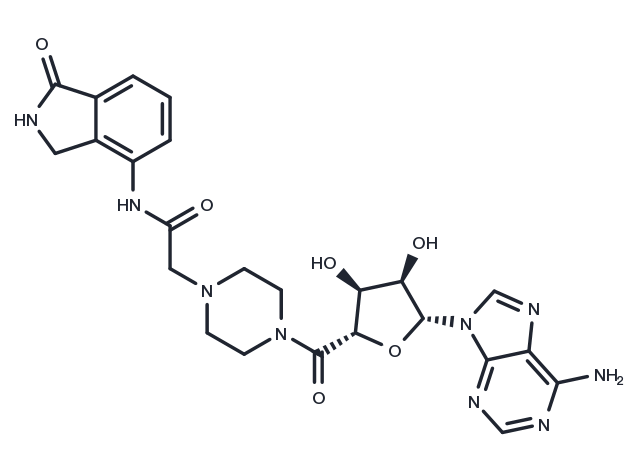Powder: -20°C for 3 years | In solvent: -80°C for 1 year


EB-47 mimics the substrate NAD+ and extends from the nicotinamide to the adenosine subsite.EB-47, a potent and selective PARP-1/ARTD-1 inhibitor with an IC50 value of 45 nM, shows modest potency against ARTD5 with an IC50 value of 410 nM.

| Pack Size | Availability | Price/USD | Quantity |
|---|---|---|---|
| 1 mg | In stock | $ 62.00 | |
| 5 mg | In stock | $ 133.00 | |
| 10 mg | In stock | $ 223.00 | |
| 25 mg | In stock | $ 397.00 | |
| 50 mg | In stock | Inquiry | |
| 1 mL * 10 mM (in DMSO) | In stock | $ 179.00 |

| Description | EB-47 mimics the substrate NAD+ and extends from the nicotinamide to the adenosine subsite.EB-47, a potent and selective PARP-1/ARTD-1 inhibitor with an IC50 value of 45 nM, shows modest potency against ARTD5 with an IC50 value of 410 nM. |
| Targets&IC50 | ARTD1/PARP1:45 nM |
| In vitro | The inhibitory effect of EB-47 on CdPARP and HsPARP was 0.86 and 1.0uM with IC50 value respectively, and the inhibitory effect on CdPARP was over 50%[1]. |
| In vivo | EB-47, at a concentration of 2 μM for a duration of 5 days, reduces the number of embryo implantation sites and the quantity of blastocysts observed on day 5. PARP1 is involved in the embryo implantation process[1]. |
| Molecular Weight | 537.53 |
| Formula | C24H27N9O6 |
| CAS No. | 366454-36-6 |
Powder: -20°C for 3 years | In solvent: -80°C for 1 year
DMSO: 60 mg/mL (111.62 mM)
You can also refer to dose conversion for different animals. More
bottom
Please see Inhibitor Handling Instructions for more frequently ask questions. Topics include: how to prepare stock solutions, how to store products, and cautions on cell-based assays & animal experiments, etc.
EB-47 366454-36-6 Chromatin/Epigenetic DNA Damage/DNA Repair PARP EB47 EB 47 inhibitor inhibit
